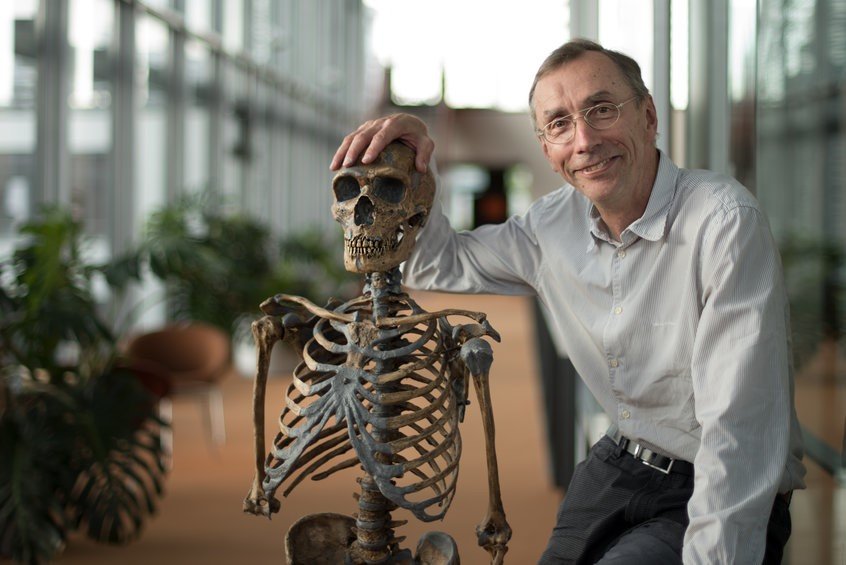The director of the Max Planck Institute for Evolutionary Anthropology in Leipzig is honoured for his pioneering work in the field of palaeogenetics, of which he is considered the founder
This year, the Nobel Prize for Physiology or Medicine goes to Svante Pääbo. One of his most important scientific successes was the decoding of the Neanderthal genome. "His work has revolutionised our understanding of the evolutionary history of modern man," said Martin Stratmann, President of the Max Planck Society. "Svante Pääbo, for example, demonstrated that Neanderthals and other extinct hominids made a significant contribution to the ancestry of modern man."

The Neanderthal and us: Svante Pääbo is fascinated by the genomes of our ancestors.
© Karsten Möbius
Svante Pääbo studied Egyptology and Medicine at Uppsala University. As a Ph.D. student in immunology, he also demonstrated that DNA can survive in ancient Egyptian mummies, thus gaining professional fame as a pioneer of the new field of palaeogenetics research. Paleogeneticists investigate the genomes of ancient organisms and draw conclusions about the course of evolution.
After his doctorate, Pääbo worked in the team of evolutionary biologist Allan Wilson at the University of California at Berkeley. From 1990, he headed his own laboratory at the Ludwig Maximilian University in Munich. In 1997, Pääbo became one of five directors at the newly founded Max Planck Institute for Evolutionary Anthropology in Leipzig, where he is still active today.
As early as the mid-1990s, Pääbo and his team were able to decipher a relatively short component of the mitochondrial DNA of a Neanderthal male. Mitochondria are tiny power plants in cells that supply them with energy and have their own DNA. This Neanderthal DNA differed considerably from the genome of modern humans. This proved that Neanderthals are not the direct ancestors of today's humans.
Since DNA sequencing methods became much more efficient in the early 2000s, Pääbo began sequencing the entire Neanderthal genome present in the cell nucleus.
A gigantic puzzle
The difficulty: After thousands of years, the bones of Neanderthals are so heavily colonised by bacteria and fungi that up to 99.9 percent of the DNA found in them originates from microbes. In addition, the small amounts of remaining Neanderthal DNA are only present in short fragments that have to be assembled like a gigantic puzzle. Many scientists believed that this task could not be solved.
However, Pääbo's team devised new solutions. The researchers worked under "clean room conditions" comparable to those in the chip industry. This enabled them to prevent the inadvertent introduction of their own DNA into the experiments. In addition, they developed more efficient extraction methods that improved the yield of Neanderthal DNA. Complex computer programs that compared the DNA fragments of ancient bones with reference genomes of chimpanzees and humans helped to reconstruct the Neanderthal genome.
In 2010, Svante Pääbo and his team succeeded in reconstructing a first version of the Neanderthal genome from bones tens of thousands of years old. Comparisons of the Neanderthal genome with the genomes of today's humans showed that modern humans and Neanderthals had produced common offspring at their meeting about 50,000 years ago, when modern humans left Africa and arrived in Europe and Asia.
Even today, therefore, the genome of today's non-African people still contains about two percent Neanderthal DNA. This genetic contribution influenced human evolution: it strengthened the immune system of modern humans, for example, but still contributes to their susceptibility to several diseases.
"Neanderthals are the closest relatives of humans today," said Svante Pääbo. "Comparisons of their genomes with those of modern humans and with those of apes enable us to determine when genetic changes occurred in our ancestors. In the future, it could also be clarified why modern humans eventually developed a complex culture and technology that enabled them to colonize almost the entire world. However, this required a more complete knowledge of the Neanderthal genome than the team had acquired in 2010.
Tracing human origins
In 2014, the team at the Max Planck Institute for Evolutionary Anthropology succeeded in deciphering the Neanderthal genome almost completely. This made a comparison with the genomes of today's humans possible. "We have found around 30,000 positions in which the genomes of almost all modern humans differ from those of Neanderthals and great apes," said Pääbo. "They answer what makes anatomically modern humans 'modern' in the genetic sense as well. Some of these genetic changes may be the key to understanding what distinguishes the cognitive abilities of today's humans from those of now extinct hominids.
Prior to this, Svante Pääbo's team had already achieved a sensation in 2012: They decoded the genome from a small bone found in the Denisova Cave in the Altai Mountains in western Siberia. The mysterious primeval humans were remotely related to the Neanderthals and contributed up to five percent to the genome of today's inhabitants of Papua New Guinea, Aboriginal Australia and other groups in Oceania.
The researchers are currently working on new methods to reconstruct DNA fragments that are even more decomposed and present in even smaller amounts. The aim is to enable research into even older DNA and genetic material from parts of the world where the survival of DNA is even rarer due to hot and humid climates.
Like father, like son
Svante Pääbo's father, Sune Bergström, was already honoured with the highest scientific award: the biochemist, together with Bengt Ingemar Samuelsson and Sir John Robert Vane, received the Nobel Prize for Physiology and Medicine in 1982 for her pioneering work on prostaglandins and related biologically active substances.
The Nobel Prize in Physiology or Medicine is one of the original five prizes donated by the Swedish inventor Alfred Nobel. It has been awarded annually since 1901 by the Swedish Karolinska Institute and is endowed with eight million Swedish crowns (approx. 775,000 euros). On 10 December, the anniversary of Alfred Nobel's death, the highest scientific award is solemnly presented by the Swedish King in Stockholm.






